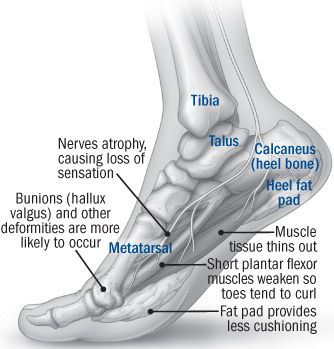Your feet take a beating throughout your entire life, and the effects of that beating can really start to show once you get older. In addition to the years of wear, tear and constantly bearing your weight, feet experience the same aging process that’s going on the in rest of your body.
Foot deformities, disorders and pain often become a way of life for older adults and, if not properly addressed or treated, the eventual result can be the loss of mobility and independence.¹ While the end result can be scary, it’s not automatically a given. With proper care and attention, you can address issues, correct problems and help your feet age more gracefully.
What Happens to Your Feet
Your feet need a lot of help to age gracefully, as many changes are taking place. The foot’s ligaments, fascia and skin start to lose elasticity, while the skin begins to harden.¹⁻⁴ Your toenails become thicker, your foot muscles become weaker, and the fatty, connective tissue and pads in the sole of your foot start to atrophy.² ³ Your feet become wider and prone to ingrown toenails and painful corns between your toes.¹ ³
As your joint movement, muscle force and ability to withstand stress decrease, your gait becomes less powerful and you begin to use shorter strides.¹ And don’t forget the overall diminishment of your senses and sensorimotor functioning, which further contributes to a decrease of balance and stability.³ ⁵ ⁶
Yet another layer of woe can come from age-related conditions that compound foot problems, such as osteoporosis, circulatory issues and degenerative joint diseases.¹⁻⁴ Diabetes is one more culprit, often resulting in foot pain due to the deterioration of the nerves in your feet and toes.⁵
Specific Deformities and Disorders
Nearly all of the foot problems that crop up in older adults can be traced back to a mechanical orthopedic problem, which either caused or aggravated the issue.⁷

-
Hammertoes and claw toes: These deformed toes can be caused by trauma, rheumatologic disease, neuromuscular issues and ill-fitting shoes.²
-
Hallux rigidus: This painful stiffness of the big toe makes it tough to squat, run, walk uphill or perform other activities where toe flexibility is required.²
-
Hallux valgus: This big toe deformity is marked by a big toe that is angled toward your other toes, brought on by genetic factors, joint shape and ill-fitting footwear.²
-
Tailor’s bunion: This large bunion on the fifth toe is caused by undue pressure on the area.³
-
Metatarsalgia: This condition involves mid-foot pain when weight is applied, caused by bone misalignment or metabolic, neurologic or traumatic conditions.²
-
Pes planus: Flatfoot is caused by a muscle imbalance in the lower leg and foot.²
-
Pes cavus: This condition involves a high arch that won’t flatten, often caused by a muscle imbalance in the leg and foot.²
-
Plantar fasciitis: This painful inflammation of the plantar fascia can be caused by excessive weight gain and long periods of standing.³
-
Achilles tendonitis, Achilles bursitis: These painful conditions involve inflammation of the Achilles tendon or heel bursae, caused by trauma, shoe friction, infections, inflammatory or metabolic conditions.³
What You Can Do
Proper foot hygiene, professional treatment of deformities, and high-quality, supportive footwear or athletic shoes can also keep foot problems at a minimum.¹ ⁵ Strengthening area muscles can often enhance functioning, as can an ongoing exercise program such as Tai Chi that contributes to your overall balance, stability and flexibility.⁶ Engaging in a regular Pilates and Foundation Training practice is another option, as both work the intrinsic and extrinsic muscles of the feet. This can help lessen or correct deformities, build arch strength and enhance your balance.
REFERENCES:
-
Edelstein JE. Foot Care for the Aging. Phys Ther. 1988;68:1882-1886.
-
Caselli MA, George DH. Foot deformities: biomechanical and pathomechanical changes associated with aging, part I. Clin Podiatr Med Surg. 2003;23:487-509.
-
Shereff MJ. Geriatric foot disorders: How to avoid undertreating them. Geriatrics. 1987;42(10):69-80.
-
Periyasamya R, Ananda S, Amminib AC. The effect of aging on the hardness of foot sole skin: A preliminary study. The Foot. 2012;22:95-99.
-
Crews RT, Yalla SV, Fleischer AE, Wu SC. A Growing Troubling Triad: Diabetes, Aging, and Falls. J Aging Res. 2013:1-6.
-
Wu G. Biomechanical characteristics of stepping in older Tai Chi practitioners. Gait Posture. 2012;36:361-366.
-
Rubin M. Biomechanical problems in the aging. J Am Podiatr Assoc. 1969;59:65- 72.
